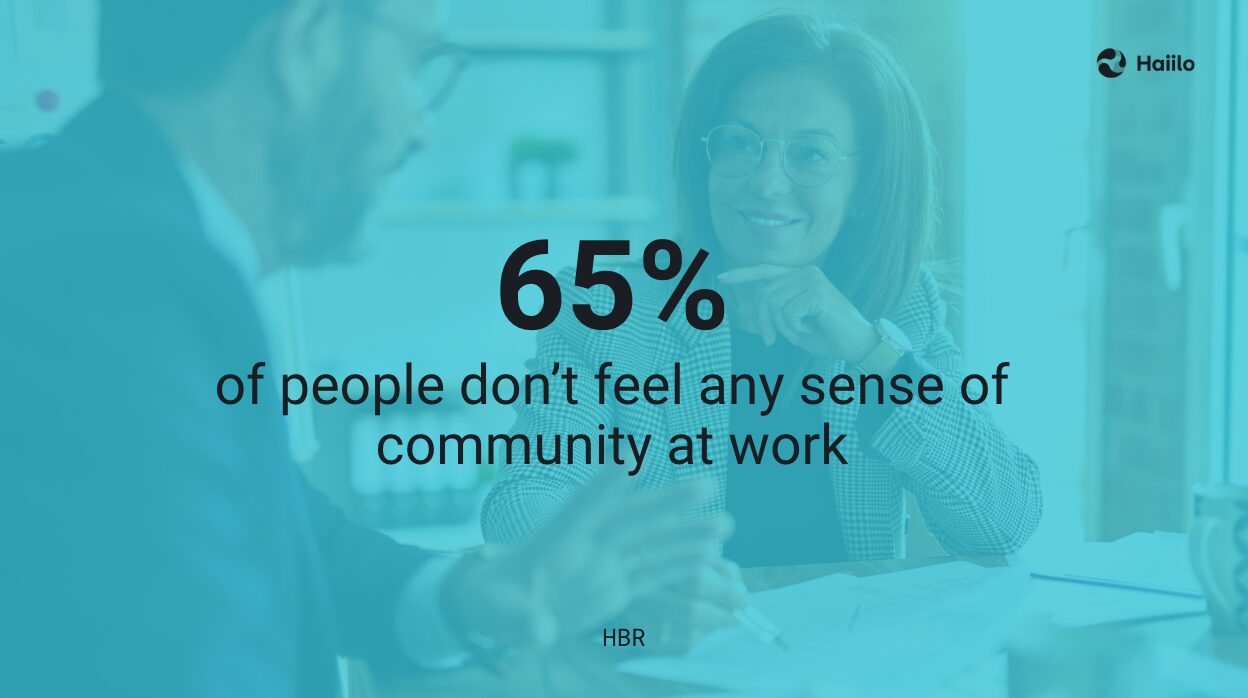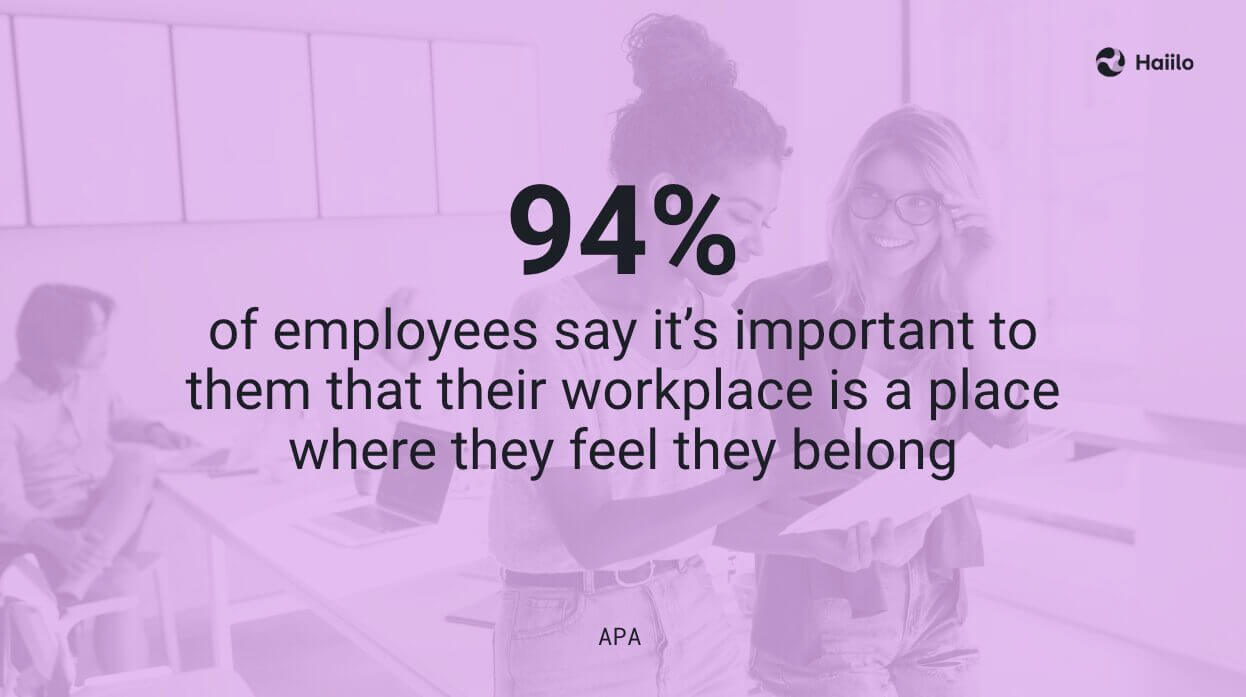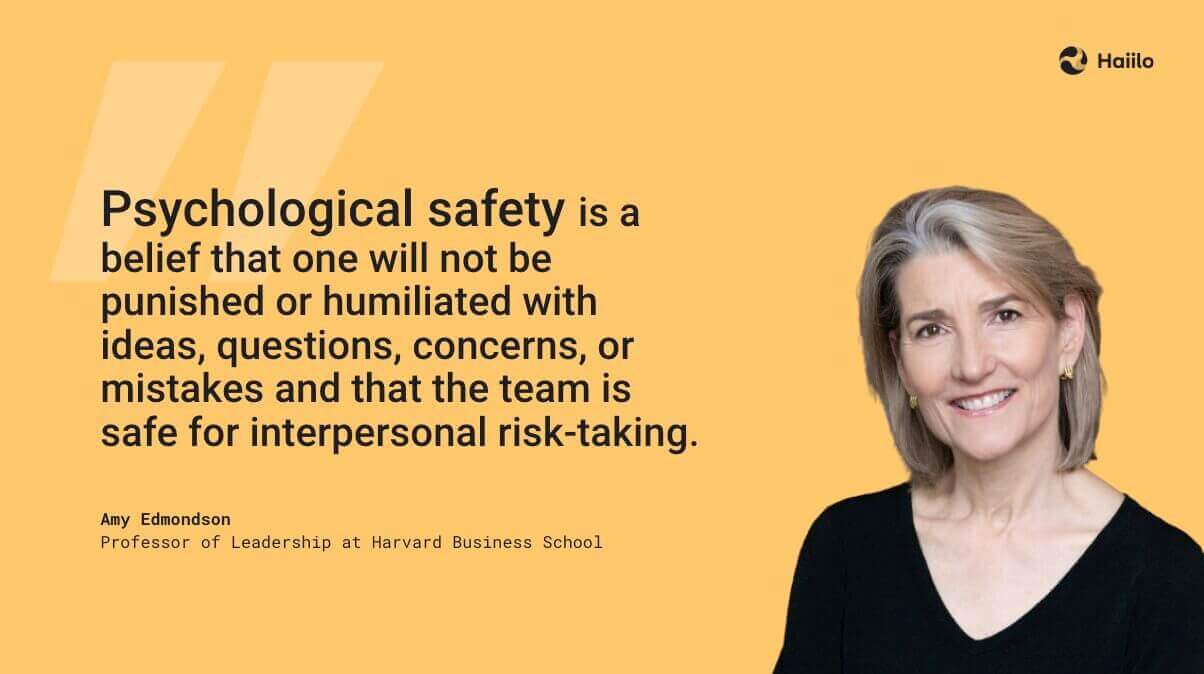Building and nurturing a sense of community in the workplace is important for improving the overall employee experience.
Employees want to be connected with their organizations, peers, and managers. Also, having a sense of belonging drives employee morale and motivation, job satisfaction, engagement, and retention.
According to research, when employees develop a sense of belonging, they are more engaged at work. On the other hand, 40% of people say that they feel isolated at work, resulting in lower organizational commitment and engagement.
As explained in an HBR article, the lack of a sense of belonging is one of the key obstacles that stands in the way of being more productive and satisfied at work. The research has found that 65% of people didn’t feel any sense of community at work.

Lonelier workers report lower job satisfaction, fewer promotions, more frequent job switching, and a higher likelihood of quitting their current job in the next six months.
So many employers today are focused on creating and nurturing engaging employee communities where employees can share their voices, collaborate efficiently, and work towards common goals.
So what can you do to foster a sense of community in your organization?
- 1. Nurture Workplace Transparency to Build Trust
- 2. Ensure Greater Organizational Alignment
- 3. Care About DEI
- 4. Get Your Leaders On Board
- 5. Create a Psychologically Safe Environment
- 6. Encourage and Drive More Feedback and Recognition
- 7. Measure Your Employees’ Pulse Regularly
- 8. Invest in Onboarding
- 9. Foster Connections Between Employees
- 10. Empower Your Workplace With the Right Technology
1. Nurture Workplace Transparency to Build Trust
Workplace trust is the bedrock of psychological safety in the workplace. Without it, employees may not feel confident or secure enough to share ideas or raise concerns. A lack of trust can arise from various factors, such as inconsistent communication, lack of workplace transparency, perceived favoritism, or a history of ignored feedback.
Ultimately, this results in a lack of sense of community and belonging in the workplace.
Therefore, organizations must encourage and nurture a transparent workplace culture. Both corporate communications functions and managers should openly and frequently share their organization’s mission, vision, and core values.
When done right, better employee satisfaction and engagement are guaranteed.
A Harvard Business Review study showed that 70% of workers say that they’re most engaged in their jobs when senior management communicates openly with them.
Create a sense of community in your organization with Haiilo
2. Ensure Greater Organizational Alignment
When employees are aligned with the company’s core values and overall business goals, they are more likely to feel like a part of a community.
Shared team and cross-functional OKRs and KPIs can help employees understand how their work contributes to the overall business success, improving employee motivation and morale.
Better organizational alignment also brings teams together, connects people, and improves team and cross-functional collaboration.
Unfortunately, only 51% of companies attempt to develop aligned goals, and among the companies surveyed, only 6% regularly revisit them.
3. Care About DEI
According to APA’s 2023 Work in America workforce survey, 94% of respondents reported that it’s somewhat or very important to them that their workplace be somewhere they feel they belong.

However, 30% of respondents reported their workplace doesn’t support them because of their identity, and 20% somewhat or strongly disagreed with the statement ‘When I’m at work, I feel like I belong.”
Diversity, equity, and inclusion initiatives are critical for building a sense of community in the workplace. When employees think they are excluded or don’t feel they are treated fairly, there is no sense of belonging and acceptance.
Organizations should, therefore, pay close attention to hiring a diverse workforce, providing equal opportunities to everyone, including employees in decision-making, and enabling their people to perform their best work.
📚 Related: 10 Steps to Build DEI Communications Strategy That Works
4. Get Your Leaders On Board
Today, people are 10 times more likely to quit their jobs because of toxic work cultures — rather than compensation or work-life balance — and three in four people say their boss is the most stressful part of their jobs.
Managers have the biggest responsibility for creating a sense of community in their teams.
Leadership styles and the way leaders manage and communicate with their teams can make a significant difference in improving the sense of community. Transformative, servant, and empathetic leaders are known to have happier teams and a more positive team culture.
Furthermore, one research confirmed that leader-motivating language is positively related to psychological safety, job meaningfulness, psychological availability, and employee advocacy.
5. Create a Psychologically Safe Environment
A psychologically safe workplace is a place where employees feel safe and encouraged to share their ideas, express concerns, ask questions, suggest improvements, and learn from mistakes. It’s a workplace where employees know they can always share their voice without fear of retribution, punishment, or embarrassment.
Feeling this way is critical for ensuring a greater sense of community in the workplace. Yet, according to a Gallup poll, just 3 out of 10 employees strongly agreed that their opinions count at work.
Employees who feel psychologically safe are more likely to have good relationships with their peers and managers, tend to go the extra mile to achieve great results, are better team players, and are unlikely to demonstrate quiet quitting behaviors.

📚 But how can you create a psychologically safe workplace environment? Check out our Ultimate Guide for Psychological Safety In the Workplace!
6. Encourage and Drive More Feedback and Recognition
Social recognition, or peer-to-peer recognition, is one of the biggest drivers for creating a better sense of community at work.
It is the act of employees empowering and acknowledging one another for great work. When recognition is embedded into core company values, it becomes the backbone of an inclusive and collaborative working environment.
Social recognition programs allow anyone in the company to share experiences, award achievements and extend congratulations. The result is a sense of belonging, purpose, and achievement throughout the workforce.
The good thing is that these programs don’t have to be monetary to work. Oftentimes, employees are even more motivated by non-monetary rewards and acts of gratitude.
7. Measure Your Employees’ Pulse Regularly
Many employers today don’t understand the current state of the sense of community in their workplaces.
To start improving, it’s important to start measuring, and the best and easiest way to do so is with simple employee surveys.
Here are a few questions that will give you great insights about how your employees feel now and what it takes to improve the sense of community:
- Do you feel connected with your peers?
- Do you feel connected with your manager?
- Do you feel your values match those of this organization?
- Do you feel you are integral to the company’s goals?
- On a scale of one to five, how much do you feel coworkers care about you?
- Do you feel like you play a pivotal role in the organization?
- Do you feel like your unique characteristics are welcomed and celebrated?
- On a scale of one to five, how strongly do you feel like you can be your authentic self at work?
- On a scale of one to five, how open do you feel your colleagues are to different perspectives?
- On a scale of one to five, how comfortable do you feel sharing your ideas, questions, and concerns with others?
8. Invest in Onboarding
Building a strong sense of community in the workplace starts with onboarding. Employee onboarding plays a critical role in shaping your employees’ overall work experience.
When new employees join your organization, you need to make sure that they feel welcome and accepted by their peers.
Proper onboarding programs go beyond the initial excitement. They also cultivate an environment where employees feel valued, supported, and connected to your company culture. Studies highlight the significant impact of onboarding on integration and understanding of company culture. A remarkable 79% of employees affirm that onboarding programs played a pivotal role in helping them integrate seamlessly.

This fact underscores the critical need to immerse new hires in the company culture, setting the stage for long-term engagement.
By infusing collaboration into the onboarding process, your organization ensures a smoother transition for new hires and establishes a strong sense of community.
9. Foster Connections Between Employees
Oxford Dictionary defines community as: “the condition of sharing or having certain attitudes and interests in common.”
To build and nurture communities it is important to create environments in which they can strive and grow.
Hence, organizations should think of actions and initiatives to connect their people. Capture and understand your employees’ interests, organize designated channels where those with the same interests can connect, or launch internal company podcasts to drive conversations and deepen connections.
But why is this so important?
Gallup research found that 30% of employees say they have a best friend at work. That percentage of workers is reportedly seven times as likely to be engaged with their jobs and produce higher-quality work!
10. Empower Your Workplace With the Right Technology
The power of workplace technology in connecting employees and fostering a sense of community in the workplace is significant.
Social intranets are the most commonly used tools for building, managing, and nurturing online communities in the workplace.
Modern intranets are designed to enhance internal communication, connect peers, and make content and critical information accessible to everyone.
So the intranet should be more than a place to go for information – it can be a powerful tool to promote a sense of community among workers and drive higher employee engagement.
Ultimately, the goal of a social intranet is to create a more connected and transparent workplace environment, where information flows more freely, employees engage in meaningful interactions, and collaboration is more efficient.










